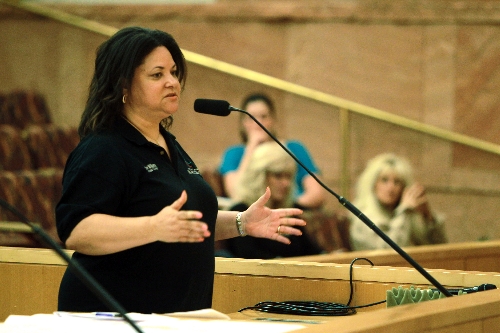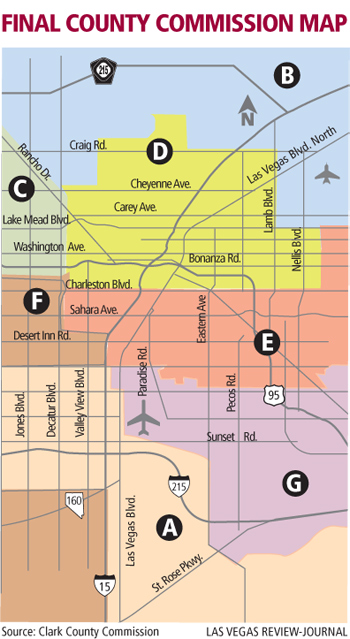Commissioners reject putting minority communities in specific districts
Clark County commissioners Tuesday chose a final map for commission voting districts that will protect their seats, rejecting minority leaders' efforts to put African-American and Hispanic communities in specific districts.
A couple dozen minority leaders, residents and two assemblymen testified, many of them in favor of a map known as "D" that would have created districts with large black and Hispanic areas.
Local Hispanic and black caucuses hoped to coalesce as many minority voters as possible to increase their power to elect leaders they prefer, including minority candidates.
But commissioners unanimously chose a map labeled "C" that they said will balance the interests of minorities and commissioners in future elections.
Jose Solorio, a Hispanic community advocate, said he was disappointed with the outcome.
"I think the commissioners were more interested in how it affected them personally rather than how it affected the community as a whole," Solorio said. "I'm going to look into it further. It just doesn't feel right."
Solorio said he doubts that the map the commissioners chose complies with federal redistricting laws that forbid splitting a minority community, adding he might pursue a legal challenge if he determines he has strong enough grounds.
Boundaries are adjusted every 10 years after a U.S. census count to spread population changes as evenly as possible through congressional, state and local voting districts.
Some commissioners must pick up 50,000 to 80,000 residents, while others must shed a similar number because of differences in district population growth.
Minority leaders contend that ethnic communities have grown and must be taken into consideration.
In the past decade, the county's Hispanic population swelled to about 569,000 from 302,000, and the African-American population increased to 204,000 from 125,000, according to census data.
Commissioners, all Democrats, have expressed concerns about not only ensuring that their new districts are solidly blue but that they don't lose too many of the voters who elected them.
Several commissioners said they thought Map C meets that goal.
Solorio and other Hispanic advocates wanted a sprawling area stretching from Craig Road to south of Charleston Boulevard to be in Commissioner Chris Giunchigliani's district.
Some black leaders wanted a large area north of Craig Road, which has had a heavy African-American influx in recent years, to be in Commissioner Lawrence Weekly's district.
But Weekly opposed that plan, saying he would pick up more than 200,000 residents who were not in his district in the last election.
Weekly also would have had to relinquish the downtown corridor, something he refused to do.
"That's too extreme," Weekly said of the boundary changes.
Yvette Williams, head of the local Democratic Black Caucus, said she would have liked the borders on Weekly's district to be extended farther north.
But Williams also is glad that Weekly won't lose the historic black district to the west, as Map D would have done.
Not all Hispanic leaders supported Map D.
Vicenta Montoya, chairwoman of the Si Se Pueda Latino Democratic Caucus, indicated that after initially trumpeting Map D, she now preferred Map C, partly because it will protect commissioners' seats. "Chris Giunchigliani and Lawrence Weekly will continue to represent constituents they've represented," Montoya said.
Commissioner Tom Collins said safeguarding Democratic districts will be good for minorities, not just commissioners.
"Every citizen will benefit from having a good representative," Collins said.
Contact reporter Scott Wyland at swyland@reviewjournal.com or 702-455-4519.



















